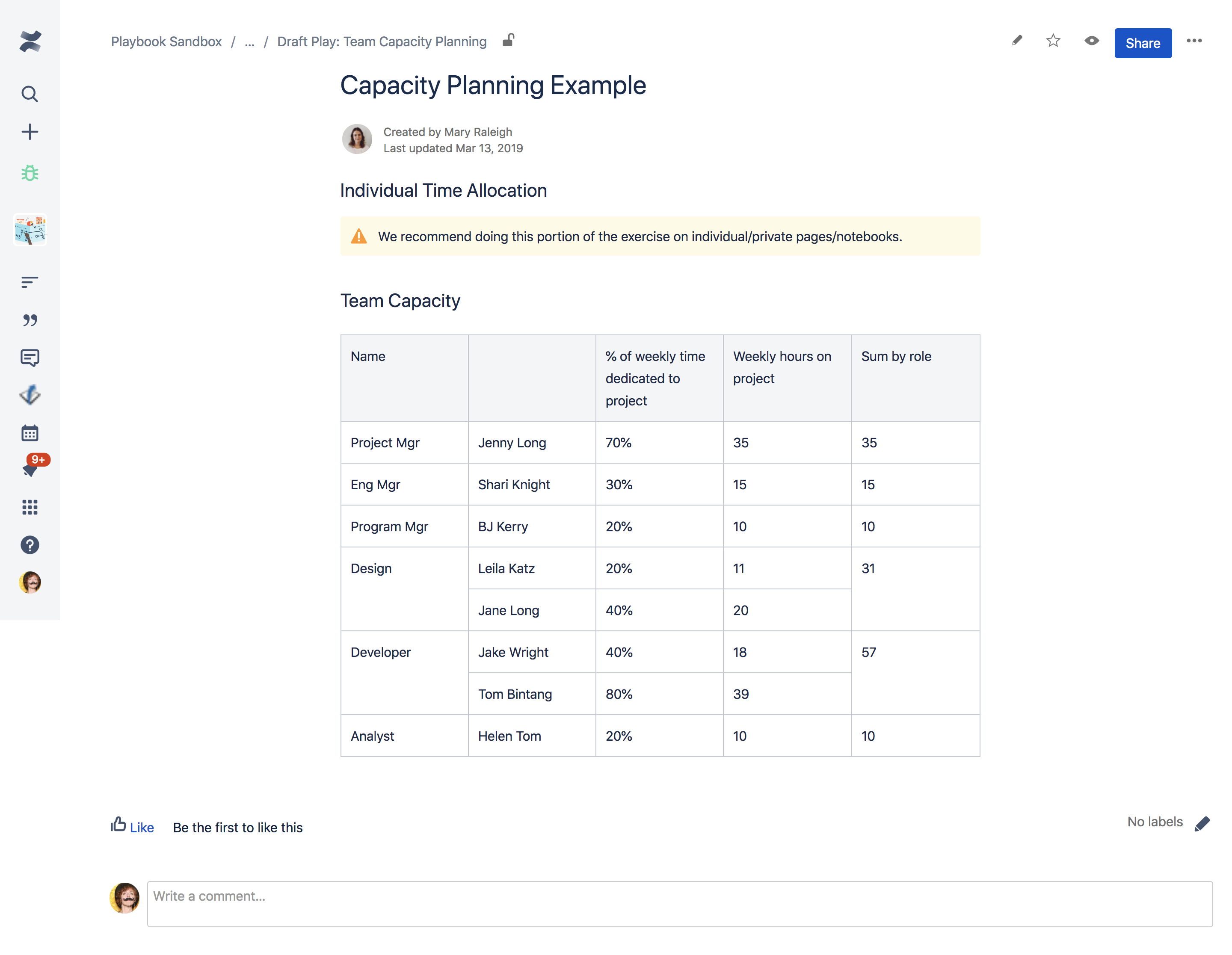Planowanie potencjału wykonawczego
Przestań opierać się na założeniach dotyczących potencjału wykonawczego i wraz z zespołem zacznijcie go planować.
CEL GRY
Zrozumieć rzeczywisty potencjał wykonawczy swojego zespołu.
Przestać opierać swoje szacunki i priorytety na przypuszczeniach.
Jeśli sesja Health Monitor wskazała na problemy ze lub ta gra może okazać się pomocna.

Uczestnicy
3–8

Czas
30 min

Trudność
Niska
Przeprowadzenie gry
Przed sesją poproś wszystkich, aby zaobserwowali i zapisali jakie formalne i nieformalne czynności składają się na ich tydzień. To przyczyni się do zwiększenia dokładności oraz przyspieszy pierwszą część ćwiczenia.
Materiały
Tablica suchościeralna lub arkusz papieru
Markery
Długopisy
Notesy
Zegar
Krok 1
Wprowadzenie (5 min)
Przedstaw to ćwiczenie jako sposób na poprawę ogólnej kondycji zespołu, aby jego członkowie mogli bez obaw dzielić się informacjami na temat godzin i dostępności w ciągu tygodnia. Poinformuj, w jaki sposób wykorzystane zostaną wyniki tego ćwiczenia — przykładowo w Atlassian wiele zespołów weryfikuje i aktualizuje swój indywidualny potencjał wykonawczy w trakcie planowania sprintu co dwa tygodnie. Wysonduj uczestników (jeśli przeprowadzasz grę ze swoim zespołem), pytając ich, jaki problem tutaj analizujecie. Zapisz na tablicy wszystkie odpowiedzi.
Przygotuj się na celowe i niezamierzone uprzedzenia, które mogą pojawić się w omawianych tutaj odpowiedziach. Zadbaj, aby uczestnicy nie próbowali uchylać się od niewygodnej prawdy lub dążyć do łatwego konsensusu.
Jeśli nie da się wskazać jednego wyraźnego problemu, musicie ustalić, którym problemem się zajmiecie — co samo w sobie powinno być dosyć odkrywcze. Po uzgodnieniu zapisz na tablicy zwięzłą definicję problemu.
Krok 2
Zaplanowanie typowego tygodnia pracy dla każdej osoby (5 min)
Poproś wszystkich, aby niezależnie od siebie spisali wszystkie rzeczy, które zazwyczaj robią w ciągu tygodnia, wraz z oszacowaniem czasu poświęcanego na ich realizację wyrażonym w liczbie godzin tygodniowo. Przyjrzyjcie się swojemu kalendarzowi, skrzynce pocztowej, zgłoszeniom Jira i kanałom czatu, aby mieć pewność, że nakreślacie pełny obraz.
Następnie oblicz, jaki procent swojego czasu pracownicy poświęcają na dany projekt, dzieląc liczbę godzin przepracowanych przy projekcie w ciągu tygodnia przez łączną liczbę godzin w tygodniu.

Porada eksperta:
Pamiętaj o uwzględnieniu czasu poświęcanego na naprawianie błędów, reagowanie na incydenty, zadania administracyjne, spotkania cykliczne, przerwy na kawę, nieplanowane rozmowy na korytarzu, spotkania indywidualne itp., a także o wydzieleniu godzin poświęcanych na realizację innych projektów.
Krok 3
Podsumowanie czasu poświęcanego na ten projekt (15 min)
Podsumuj potencjał wykonawczy zespołu w tabeli. Najpierw pogrupuj wszystkie osoby według pełnionej roli. Przy każdej roli zapisz poszczególne osoby w kolejnych wierszach, uwzględniając łączną liczbę godzin, jakie poświęcają tygodniowo na dany projekt. Po zapisaniu każdej osoby pełniącej tę samą rolę, zsumuj łączną liczbę godzin dostępną dla tej roli.
Powtarzaj do momentu zapisania w tabeli wszystkich ról i członków zespołu.

Na przykład…
Mniej więcej tak powinna wyglądać Twoja tabela planowania potencjału wykonawczego. (Jeśli wygląda inaczej, no cóż… nie będziemy przecież tego oceniać).
Krok 4
Uzgodnienie następnych kroków (5 min)
Po wyznaczeniu punktu odniesienia dla potencjału wykonawczego musisz ustalić częstotliwość weryfikowania przydziałów w zespole i sprawdzić, czy nie ma obowiązków bez przypisanych właścicieli. Zalecamy wykorzystanie wyników tej sesji w charakterze wytycznych do opracowania ćwiczeń związanych z szacowaniem i ustalaniem priorytetów na potrzeby nadchodzących projektów Twojego zespołu.
Gotowe?
Pamiętaj, aby przeprowadzić z zespołem pełną sesję Health Monitor lub sporządzić listę punktów kontrolnych w celu sprawdzenia, czy robicie postępy.
Różnice
Ekspresową 10-minutową wersję tego ćwiczenia można wykonać w ramach gry Rozpoczęcie projektu IT. W przypadku wersji ekspresowej poproś członków zespołu, aby przygotowali listę działań, a następnie daj im pięć minut na własne obliczenia oraz pięć minut na podsumowanie potencjału wykonawczego zespołu.
Masz apetyt na więcej… porad strategicznych?
Podaj adres e-mail poniżej, aby otrzymywać powiadomienia o dodaniu nowych sesji monitorowania wydajności i gier.
Chcesz przesłać opinię?
Zostaw pytanie lub komentarz w witrynie społeczności Atlassian.
